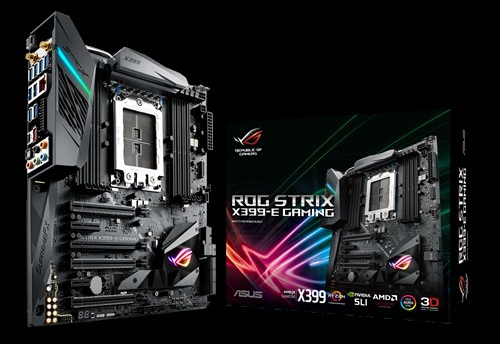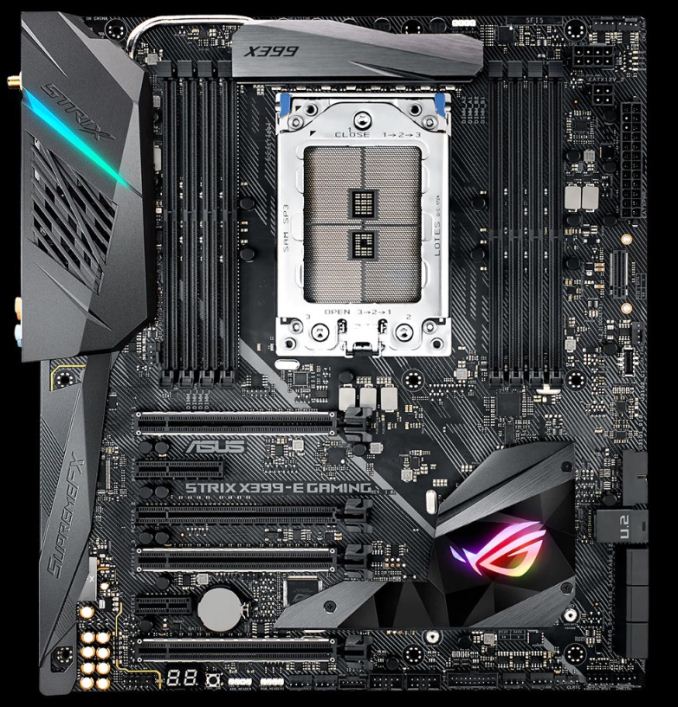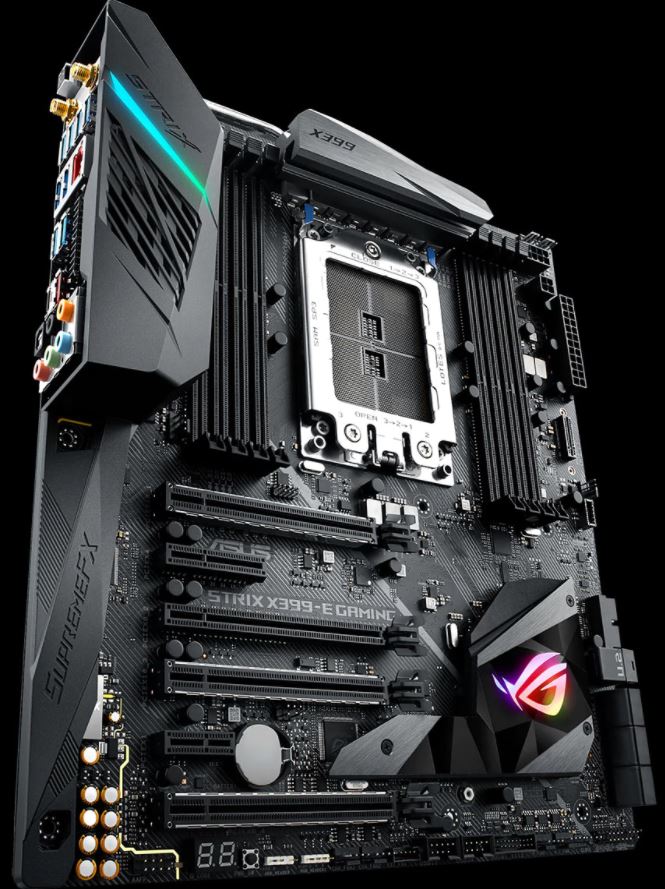An AMD Threadripper X399 Motherboard Overview: A Quick Look at Seven Products
by Ian Cutress & Joe Shields on September 15, 2017 9:00 AM ESTASUS ROG Strix X399-E Gaming
With the advent of eSports and the ability to stream and even broadcast your own gaming sessions, PC gaming has gained a significant amount of momentum the past few years. So much so, many (if not all) of the motherboard partners have latched on to the nomenclature and started entire lines for 'gaming' motherboards. ASUS is no different with gaming based motherboards, out for generations now under the ROG name, and continues to do so on the X399 Threadripper platform in the ROG Strix X399-E Gaming. Strix as a brand has migrated from a 'zero-noise' implementation to the more budget oriented gaming products from ASUS.
The ROG Strix falls between the Zenith Extreme and the Prime with a mix of features. For example, the Strix includes WiFi and Bluetooth connectivity, like the flagship Zenith Extreme, or that the Prime and Strix each have a single Intel I211-AT Gigabit LAN while the Zenith has three network ports including a 10 GbE. The Strix X399-E Gaming has eight DRAM slots, supports multiple GPUs (SLI and Crossfire), uses the latest audio codec (Supreme FX S1220A for the Strix), a capable VRM, multiple storage options, and RGB lighting among other features.
Looking over the board in detail, we'll start at the top. First, the VRM configuration is an eight-phase design. It is cooled by dual heat sinks running along the top of the socket with the second sitting between the memory slots and rear I/O. Extra cooling on the VRMs is provided by an included 40mm fan sitting under the I/O shroud (similar to the Zenith). Both EPS connectors, an 8-pin and 4-pin, as well as the 24-pin ATX connector, are in the top right-hand corner of the board. Below that is the second M.2 slot. An M.2 drive in this slot, like in the Prime, sticks out from the board instead of laying flat. ASUS does include an M.2 bracket for the slot to assist with supporting the standing device.
Continuing to move down the motherboard, below the vertical M.2 slot is the USB3.1 (10 Gbps) header fed from the chipset. For cases that have front panel USB 3.1 ports, this is typically the header used for that connectivity. Below that is the single U.2 port and six SATA ports.
The chipset heatsink on the ROG Strix houses RGB LEDs that can be adjusted with the AURA Sync software. The only other LEDs on the board are located on the I/O cover. The chipset heatsink extends on the bottom between the last two full-length PCIe slots and covers the first M.2 slot providing additional cooling for those devices.
The Strix offers four full-length PCIe slots, three use a reinforcing guard and is where users will slot their graphics cards for optimal performance. The PCIe arrangement allows for up to a triple slot video card between slot 1 and slot 3, and a dual slot card will fit between between slot 3 and slot 4. Slot breakdowns are x16 for single, x16/x16 for dual GPUs, and x16/x16/x8 when using three GPUs. Additionally there is one PCIe x1 slot, a PCIe x4 slot, and full-length PCIe slot (x4). These slots distinguish themselves by not having the reinforcement.
Across the bottom of the board are more onboard headers. These include external addressable RGB LED headers, fan headers, and USB3.0 headers. It also has a debug display as well as a small power button for testing outside of the case. On the left side of the board is where the audio parts are housed. Mostly concealed under the shroud is an EMI protected ALC1220A codec using upgraded filter caps, and PCB separation of the audio components from the rest of the board.
The rear I/O panel is fairly busy with a BIOS reset button, wireless connectivity, eight USB 3.0 ports, and the Gigabit Ethernet port taking up most of the real estate. USB 3.1 Type-A and Type-C ports from the ASMedia controller are also present, with the audio jacks, including SPDIF output, rounding out the rear panel.
| ASUS ROG Strix X399-E Gaming | |
| Warranty Period | 3 Years |
| Product Page | Link |
| Price | N/A |
| Size | ATX |
| CPU Interface | TR4 |
| Chipset | AMD X399 |
| Memory Slots (DDR4) | Eight DDR4 Supporting 128GB Quad Channel Up to 4133 MHz (OC) |
| Network Connectivity | 1 x Intel I211-AT GbE |
| Wireless Network | Wi-Fi 802.11 a/b/g/n/ac |
| Onboard Audio | SupremeFX S1220A |
| PCIe Slots for Graphics (from CPU) | 4 x PCIe 3.0 x16 Supports SLI/CF |
| PCIe Slots for Other (from Chipset) | 1 x PCIe 2.0 x4 (max) 1 x PCIe 2.0 x1 |
| Onboard SATA | 6x Supporting RAID 0/1/10 |
| Onboard SATA Express | None |
| Onboard M.2 | 2 x PCIe 3.0 x4 - PCIe or SATA |
| Onboard U.2 | 1 x PCIe 3.0 x4 |
| USB 3.1 | 1 x Header 1 x Rear Panel Type-A 1 x Rear Panel Type-C |
| USB 3.0 | 8 x Rear-Panel 2 x Header |
| USB 2.0 | 2 x Header |
| Power Connectors | 1 x 24-pin EATX 1 x 8-pin ATX 12V 1 x 4-pin ATX 12V |
| Fan Headers | 1 x M.2 1 x CPU 1 x CPU OPT 3 x Chassis 1 x AIO_PUMP 1 X w_PUMP+ 1 x 5-pin EXT_FAN |
| IO Panel | 1 x Intel NIC 1 x USB 3.1 Type-A 1 x USB 3.1 Type-C 8 x USB 3.0 1 x Optical S/PDIF out 5 x Audio jacks 1 x USB BIOS Flashback Button 1 x 2x2 Wi-Fi 802.11 a/b/g/n/ac |
ASUS mentioned pricing for the Strix X399-E Gaming to be at a more affordable price than their flaghsip ROG Zenith Extreme. It is currently available through smaller distributors, perhaps as a pre-order, but not found on Newegg or Amazon at the time of writing (9/11).













99 Comments
View All Comments
Holliday75 - Friday, September 15, 2017 - link
Where is this magical land?ddriver - Friday, September 15, 2017 - link
Actually, many people in the developed world call a technician for even trivial things like changing a fuse. Building a computer, as simple as it is, is out of this world achievement in their eyes.mapesdhs - Tuesday, September 19, 2017 - link
Weird, normally such a person wouldn't even ask a relevant question. My gf doesn't care what my HTPC has inside, as long as it runs YT and plays DVDs, etc. ok, and she can use the wifi link to find stuff for her Kindle.mapesdhs - Tuesday, September 19, 2017 - link
NB: I was replying to ddriver saying, "So a dumb wife having to approve your purchases is a realistic scenario? :D".Vatharian - Friday, September 15, 2017 - link
No anything that has more than 2 HDDs is a server. I also have gaming PC that has 10 HDDs. They are low capacity, and connected to low-end HBA, but this way I won't ever lose any data. And I just can't think of a reason to pay well over $1000 for 10 disk-capable NAS.ddriver - Friday, September 15, 2017 - link
You really must love noise then, and waste power. Besides, the more drives, the more drives, the higher the odds some of them die. You can get a couple of large HGST drives, huge capacity, excellent reliability. The odds of both drives failing is minuscule, and would require the entire system burning up, which would be just as devastating regardless of many drives you have. You don't require 10 drives for the sake of the number. 10 TB HGST HE10 are like 350$.Besides, TR doesn't fall neither in the "budget", nor in the "gaming" category. That's a workstation CPU, and it actually does pretty bad in gaming, considering its price. Paying that much money for a product you are not gonna use for the job it is best at and complaining the mobo doesn't fit your senseless and wrong usage scenario - that's kinda dumb.
It is a new high end product, you are gonna put new high end components in it, not 10 poor old tiny HDDs.
Guwapo77 - Saturday, September 16, 2017 - link
It's not bad at gaming, however, it is not wise to use this solely for gaming. A workstation that you can use to handling your day to day workload that just happens to be fairly decent for gaming when you have time.Anyone building a gaming rig that chooses to buy a TR fails at life.
cyberguyz - Thursday, December 28, 2017 - link
It has 2x M.2 slots not 3x. You need an add-in card to get the 3rd with this onefazalmajid - Sunday, September 17, 2017 - link
Annoying, but a LSI add-in HBA will generally outperform integrated SATA by a wide margin.karatekid430 - Thursday, October 26, 2017 - link
Ask the manufacturers to make M.2 PCIe cards with a SATA controller and a heap of SATA ports on board. I want them to provide these, and exclude SATA from motherboards, to save space and reduce complexity and cost. That way, the motherboards are cleaner for people who only require NVMe, and allow for people who need SATA to sacrifice M.2 slots for SATA.